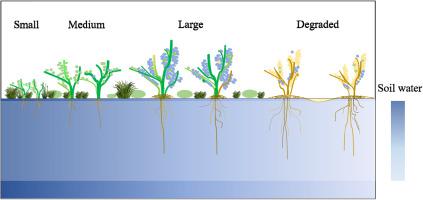Science of the Total Environment ( IF 9.8 ) Pub Date : 2020-06-23 , DOI: 10.1016/j.scitotenv.2020.140498 Chencheng Zhang 1 , Yunqiang Wang 2 , Xiaoxu Jia 3 , Ming'an Shao 4 , Zhisheng An 5

|
The intensive introduction of shrubs to drylands can alter species composition and affect a series of biotic and abiotic processes. This topic has attracted increasing attention by researchers. To assess the response of soil properties to vegetation succession in arid regions of China, we measured the soil water content (SWC) to a depth of 5-m and determined soil properties of surface (0–5 cm) and subsurface (20–25 cm) layers in areas of natural grasses (NGs) and planted shrubs (PSs). The patch size of Caragana korshinskii shrubs resulted in different soil water storage losses (small shrub patch: 206.67 ± 35.58 mm; medium shrub patch: 416.88 ± 35.12 mm; large shrub patch: 588.63 ± 72.00 mm; degraded shrub patch: 740.54 ± 17.00 mm). Shrub cover showed an initial increase but then decreased as shrubs extracted soil water from the deep soil layers (>1 m). The species richness index in the PSs decreased with increasing shrub patch sizes. Surface soil organic carbon (SOC), extractable nitrogen (NH4+-N and NO3−-N), and available phosphorous contents and saturated soil hydraulic conductivity (Ks) in the PSs were all significantly (p < 0.05) lower than those in NGs. Soil particles in the range of 0.002–0.2 mm explained 28.0% and 47.3% of the total variability of these surface indices under NGs and PSs, respectively. The differences in SOC, NH4+-N, NO3−-N, Ks, and field capacity between the surface and subsurface layers declined significantly (p < 0.05). The introduction of shrubs affected the plant community by increasing the spatial heterogeneity of soil resources (e.g. water and nutrient contents). Therefore, the strong feedback between SWC and vegetation succession should be carefully considered when revegetating drylands. The evaluation of regional soil property responses to vegetation succession aids in a better understanding of soil water–vegetation feedback and provides important implications for future revegetation in arid regions.


























 京公网安备 11010802027423号
京公网安备 11010802027423号